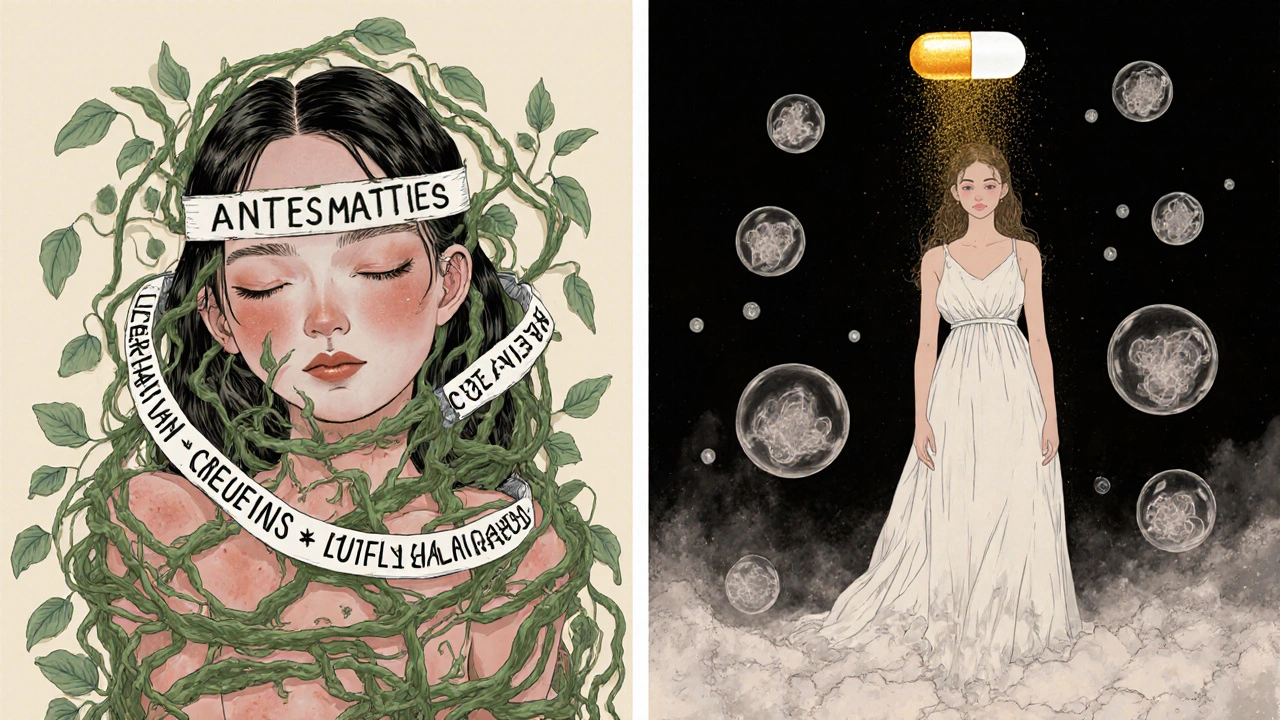Acne Treatment Cost Calculator
Calculate Your Treatment Costs
Compare long-term costs of Tretiva (isotretinoin) with other acne treatments
Cost Comparison
Tretiva is a one-time investment that often pays for itself by eliminating years of ongoing treatments
Why Tretiva (Isotretinoin) Is Still the Go-To for Severe Acne
If you’ve tried every cream, cleanser, and antibiotic for your acne and nothing stuck, you’re not alone. Tretiva, the brand name for isotretinoin, isn’t the first thing doctors reach for-but it’s often the last thing that works. It doesn’t just treat acne; it resets your skin’s entire oil production system. For people with cystic acne that scars or refuses to clear, Tretiva can be life-changing. But it’s not without risks, side effects, or alternatives. So how does it stack up against other options? Let’s break down what actually works, what doesn’t, and what you need to know before starting.
How Tretiva (Isotretinoin) Actually Works
Tretiva is a synthetic form of vitamin A. It doesn’t kill bacteria or reduce inflammation like antibiotics or topical creams. Instead, it attacks acne at the source: your sebaceous glands. In just 4 to 6 weeks, Tretiva shrinks those glands by up to 90%, slashing oil production. Less oil means fewer clogged pores, less bacteria, and fewer angry breakouts. Most people see major improvement within 3 to 4 months. By the end of a typical 15- to 20-week course, about 85% of users experience long-term remission-some for years, even decades.
That’s why dermatologists call it the only acne treatment that can offer a potential cure. Unlike other options that need constant use, Tretiva often ends the battle for good.
Top Alternatives to Tretiva
Not everyone can or should take Tretiva. Some have medical conditions, others are pregnant or planning to be, and many just want to avoid its side effects. Here are the most common alternatives-and how they compare.
1. Oral Antibiotics (Doxycycline, Minocycline)
These are the most common first-line oral treatments. They reduce inflammation and kill acne-causing bacteria. Doxycycline is usually taken daily for 3 to 6 months. Many people see improvement, but acne often returns after stopping. Long-term use can lead to antibiotic resistance, yeast infections, and sun sensitivity. They’re good for moderate acne, but useless for severe cystic cases.
2. Topical Retinoids (Tretinoin, Adapalene)
These are vitamin A derivatives applied directly to the skin. They unclog pores and speed up cell turnover. Adapalene (available over-the-counter as Differin) is gentler than tretinoin. They work slowly-expect 8 to 12 weeks for results-and don’t touch oil production. Great for mild to moderate acne, but won’t fix deep cysts. Often used alongside other treatments, not as a standalone for severe cases.
3. Hormonal Therapies (Spironolactone, Birth Control Pills)
For women with hormonal acne-breakouts along the jawline, chin, or neck-these can be very effective. Spironolactone blocks androgen receptors, reducing oil. Birth control pills lower testosterone levels. Results take 2 to 4 months. Side effects include breast tenderness, irregular periods, and (rarely) high potassium levels. Not an option for men or people who can’t take estrogen.
4. Laser and Light Therapies (Blue Light, IPL, Photodynamic Therapy)
These use light to kill bacteria and shrink oil glands. They’re non-invasive and don’t involve pills. But they require 6 to 12 sessions over months. Results are temporary-acne usually comes back within 6 to 12 months. Costs range from $200 to $600 per session. Useful for people who can’t take oral meds, but not a replacement for Tretiva in severe cases.
5. Isotretinoin Generics (Accutane, Claravis, Sotret)
Tretiva is just one brand of isotretinoin. Others include Accutane (the original), Claravis, and Sotret. They’re chemically identical. The only difference is price and manufacturer. Accutane was discontinued in the U.S. in 2009, but generics are widely available. Tretiva often costs less than brand-name Accutane did. Insurance usually covers generics, so you’re not paying extra for the brand name.
Side Effects: What Tretiva Can Do to Your Body
Let’s be honest-Tretiva has a reputation. Dry skin, chapped lips, nosebleeds, and muscle aches are common. Most are mild and manageable with moisturizers and lip balm. But some risks are serious:
- Pregnancy risk: Isotretinoin causes severe birth defects. Women must use two forms of birth control and get monthly pregnancy tests. This is non-negotiable.
- Mental health: Some users report depression or mood changes. Studies are mixed, but doctors screen for history of depression before prescribing.
- Liver and cholesterol: Blood tests are required before and during treatment to monitor liver enzymes and triglycerides.
- Eye and vision: Dry eyes and night vision changes can happen. Rarely, permanent vision damage has been reported.
These risks are why Tretiva is tightly controlled in the U.S. through the iPLEDGE program. You can’t get it without regular check-ins and paperwork.

Who Should Avoid Tretiva
Tretiva isn’t for everyone. Avoid it if you:
- Are pregnant, planning pregnancy, or breastfeeding
- Have liver disease or very high triglycerides
- Have a history of depression or suicidal thoughts (unless closely monitored)
- Are under 12 years old
- Are allergic to vitamin A derivatives
If you’re on other medications-especially tetracycline antibiotics, vitamin A supplements, or certain seizure drugs-talk to your doctor. Interactions can be dangerous.
Cost and Accessibility: What You’ll Really Pay
Tretiva isn’t cheap, but it’s often cheaper than you think. Without insurance, a 30-day supply can cost $200 to $500. With insurance, most people pay $10 to $50 per month. Generic isotretinoin (like Sotret or Claravis) is usually the most affordable option. Some pharmacies offer discount programs-GoodRx often lists prices under $50 for a 30-day course.
Compare that to laser treatments: $1,200 to $7,200 for a full course. Or monthly prescriptions for spironolactone and topical retinoids: $30 to $80 each, year after year. Tretiva is a one-time investment. For many, it pays for itself by ending years of failed treatments.
Real Results: What Patients Actually Experience
One patient in Austin, 24, had cystic acne since age 15. She tried 7 different antibiotics, 4 topical regimens, and two rounds of blue light therapy. Nothing lasted. After 5 months on Tretiva, her skin cleared. Three years later, she’s had one small breakout. She says, "I didn’t realize how much I was avoiding mirrors until I didn’t need to anymore." Another man, 28, took Tretiva after his acne left deep scars. He had mild liver enzyme spikes but managed them with diet changes. His skin improved by 90%. He now uses a gentle retinoid once a week to maintain results.
These aren’t outliers. A 2023 study in the Journal of the American Academy of Dermatology tracked 1,200 patients on isotretinoin. 78% had no acne recurrence 5 years after treatment. Only 12% needed a second course.

When to Choose Tretiva Over Alternatives
Here’s a simple guide:
- Choose Tretiva if: You have severe, scarring, or treatment-resistant acne. You’re done trying things that don’t work. You can commit to monthly blood tests and birth control (if applicable).
- Choose antibiotics if: You have moderate acne and want a quick fix. You’re not ready for long-term commitment or side effects.
- Choose topical retinoids if: Your acne is mild to moderate and you prefer non-systemic treatment.
- Choose hormonal therapy if: You’re a woman with jawline acne tied to your cycle.
- Choose lasers if: You can’t take oral meds and want to avoid chemicals.
What Happens After Tretiva?
Stopping Tretiva doesn’t mean your skin goes back to square one. Most people don’t need to restart. But your skin may be more sensitive. Use gentle cleansers, avoid harsh scrubs, and wear sunscreen daily. Some dermatologists recommend low-dose retinoids or niacinamide to keep pores clear.
Don’t expect perfect skin overnight. It takes 2 to 6 months after finishing to see your final results. Some people get minor breakouts during this transition. That’s normal. If acne returns aggressively, your doctor may suggest a second course-usually at a lower dose.
Final Thought: It’s Not About Fear, It’s About Fit
Tretiva isn’t a miracle drug. It’s a powerful tool with real risks. But for people with severe acne, it’s often the only thing that gives back control. The alternatives? They’re band-aids. Tretiva is the surgery.
If your acne is ruining your confidence, your social life, or your mental health, don’t wait for "one more cream" to work. Talk to a board-certified dermatologist. Get blood work. Ask about the iPLEDGE program. Understand the risks-but don’t let fear stop you from healing.
Is Tretiva the same as Accutane?
Yes, Tretiva is a generic version of isotretinoin-the same active ingredient as Accutane. Accutane was the original brand name, but it was discontinued in 2009. Today, Tretiva, Claravis, and Sotret are all generic isotretinoin products. They work the same way, have the same side effects, and are equally effective. The only difference is the manufacturer and price.
Can I take Tretiva if I’m planning to get pregnant?
No. Isotretinoin causes severe birth defects. Women must avoid pregnancy during treatment and for at least one month after stopping. Some doctors recommend waiting three months. You’ll need two forms of birth control and monthly pregnancy tests under the iPLEDGE program. If you’re planning pregnancy, explore alternatives like hormonal therapy or topical treatments first.
Does Tretiva cause weight gain?
Weight gain isn’t a proven side effect of isotretinoin. Some people report it, but studies show no consistent link. Changes in appetite, dry mouth, or reduced physical activity due to fatigue might cause minor fluctuations. If you notice sudden weight gain, check with your doctor-it could signal high triglycerides or another issue.
How long do I need to take Tretiva?
Most courses last 15 to 20 weeks, or about 4 to 5 months. The dose is based on your weight-usually 0.5 to 1 milligram per kilogram of body weight per day. Some people finish early if their acne clears quickly. Others need a second course if acne returns. Your doctor will adjust based on your response and blood test results.
Can I drink alcohol while on Tretiva?
It’s best to avoid alcohol. Both alcohol and isotretinoin are processed by the liver. Combining them increases the risk of liver damage and elevated triglycerides. Even moderate drinking can raise these risks. If you drink occasionally, talk to your doctor. Some say one drink a week is okay, but many recommend total avoidance during treatment.
Will my acne come back after Tretiva?
For most people, acne stays gone. About 75% to 85% of users don’t need another course. Some get occasional mild breakouts, especially during hormonal shifts. If acne returns severely, a second course is often effective-and usually shorter. Maintenance with topical retinoids can help prevent flare-ups.


Charlos Thompson
October 28, 2025 AT 07:28So let me get this straight-you’re telling me the only thing that actually cures cystic acne is a vitamin A derivative that turns your skin into a desert, your lips into cracked leather, and your liver into a stress ball? And we call this medicine? I mean, I get it-it works. But it’s like using a flamethrower to kill a mosquito. And don’t even get me started on iPLEDGE. That’s not a program, that’s a Kafkaesque bureaucratic nightmare wrapped in a HIPAA compliance blanket. At this point, I’d rather just get a tattoo that says ‘I Survived Tretiva’ and call it a day.
Peter Feldges
October 28, 2025 AT 09:04While I appreciate the comprehensive breakdown of isotretinoin’s mechanisms and comparative efficacy, I must respectfully underscore the ethical imperative of informed consent in dermatological interventions of this magnitude. The pharmacokinetic profile of isotretinoin, particularly its teratogenic potential, necessitates a multidisciplinary approach involving endocrinology, psychiatry, and obstetrics. One cannot overstate the significance of the iPLEDGE protocol-not as a bureaucratic hurdle, but as a non-negotiable safeguard. That said, the cost-effectiveness analysis presented is compelling; the long-term economic burden of chronic acne management versus a single-course intervention warrants serious consideration in public health policy.
Richard Kang
October 29, 2025 AT 07:34Okay but like-why is everyone acting like Tretiva is some kind of magic wand?? I mean, I took it and my skin cleared but my eyebrows fell out, I cried every day for two months, I couldn’t open my eyes in the morning because they were so dry, and my mom thought I was dying?? And then, like, three months later, I got one pimple and I panicked like it was the end of the world?? Like, yeah it works, but it’s not a cure, it’s a temporary truce with your own body?? And don’t even get me started on the alcohol thing-I had one beer and my liver felt like it was being stabbed by a rusty spoon??
Rohit Nair
October 29, 2025 AT 11:04As someone from India who struggled with acne for 8 years, I can say Tretiva changed my life. I tried everything-home remedies, Ayurveda, expensive creams, even laser treatments that cost more than my monthly rent. Nothing worked. When I started Tretiva, I was scared too. But after 5 months, my skin was smooth for the first time. I didn’t know I could smile without covering my face. I still use a gentle cleanser and sunscreen daily. It’s not perfect, but it’s peace. If you’re scared, talk to your doctor. You’re not alone.
Wendy Stanford
October 31, 2025 AT 06:19It’s fascinating how society treats acne as a cosmetic issue rather than the profound psychological trauma it inflicts-especially in adolescence, when identity formation is so fragile. The stigma attached to facial imperfections is a cultural artifact of superficiality, reinforced by social media algorithms that glorify flawless skin as the ultimate metric of worth. Tretiva, then, isn’t merely a pharmaceutical intervention-it’s a form of ontological liberation. To be seen without the mask of acne is to reclaim one’s right to exist unapologetically in a world that equates beauty with virtue. And yet, the medical system still treats it like a side effect to be managed rather than a crisis to be addressed with empathy.
Jessica Glass
November 1, 2025 AT 09:31Oh please. You all act like Tretiva is the holy grail. I’ve seen people on it who turned into zombies-dry as a bone, mood swings like a broken thermostat, and then they come back with ‘perfect skin’ and act like they won the lottery. Newsflash: you’re not special. You just didn’t die. And let’s not pretend the ‘85% remission’ stat isn’t cherry-picked. I know three people who had to go back on it. One got liver damage. Another started seeing shadows. And yet, here we are, worshiping a drug that basically turns your body into a science experiment. If you’re not terrified, you’re not paying attention.
Krishna Kranthi
November 2, 2025 AT 01:27Bro Tretiva is the real MVP but also the villain in the same movie. I took it in Delhi, no iPLEDGE, just a doc who said ‘take it, you’ll be fine’. Skin cleared in 4 months. Lips cracked like the Gobi desert. No alcohol. No sun. No makeup. One time I sneezed and my nose bled. But I didn’t care. I saw my reflection and didn’t hate it. That’s the thing nobody says-you’re not just treating acne, you’re unlearning how to hate yourself. Also, generics are fine. Don’t pay extra for the brand name like a sucker.
Lilly Dillon
November 3, 2025 AT 06:26I took Tretiva two years ago. My skin is still clear. I don’t think about it anymore. I just use sunscreen and wash my face. It’s weird how something so intense can lead to such quiet normalcy. I didn’t tell most people I was on it. Didn’t need their opinions. Just needed it to work.
Shiv Sivaguru
November 4, 2025 AT 21:57Why are we even talking about this? Everyone knows isotretinoin is just Big Pharma’s way of making you dependent on dermatologists. You think it’s a cure? Nah. It’s a subscription model with side effects. And don’t get me started on the ‘two forms of birth control’ rule-like, who decided women are the only ones responsible for preventing birth defects? Men take it too, and they don’t have to prove they’re not reproducing. Double standard much?
Jesse Weinberger
November 5, 2025 AT 11:23Okay but what if the whole acne-is-a-disease narrative is just a scam to sell drugs? Like, maybe acne is just your body’s way of detoxing? Maybe it’s not about oil glands-it’s about gut health? I read this guy on YouTube who cured his acne by eating only fermented cabbage and doing breathwork. No meds. No lasers. Just vibes. And now his skin looks like a baby’s butt. Maybe we’ve been lied to. Maybe Tretiva is the problem, not the solution.
Emilie Bronsard
November 6, 2025 AT 21:32I’m so glad this post exists. I’ve been terrified of Tretiva for years, but after reading this, I feel like I finally understand the trade-offs. Thank you for not sugarcoating it. I’m going to talk to my dermatologist next week.
John Bob
November 8, 2025 AT 18:12Let’s not ignore the elephant in the room: the iPLEDGE program is a government-sanctioned surveillance system disguised as patient safety. Monthly pregnancy tests? Mandatory counseling? Mandatory online modules? This isn’t healthcare-it’s control. And the fact that you can’t get isotretinoin without jumping through these hoops suggests the real goal isn’t patient well-being-it’s liability avoidance. They’d rather you suffer with acne than risk a lawsuit. That’s not medicine. That’s fear-based bureaucracy.
Alex Grizzell
November 9, 2025 AT 13:36You got this. I was skeptical too. Took it in my 20s, felt like a zombie for a bit, but damn-it worked. Now I’m acne-free and I don’t even miss it. Just hydrate. Use sunscreen. Don’t stress. And if your skin flares up a little later? That’s normal. You’re not failing. You’re just human. 💪